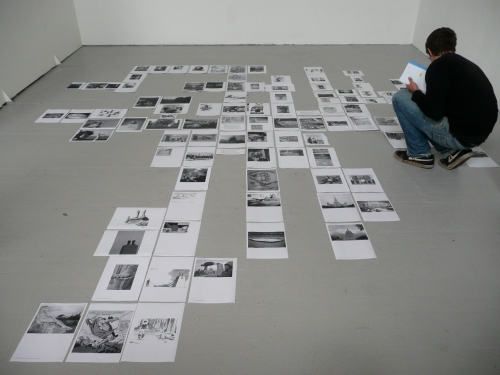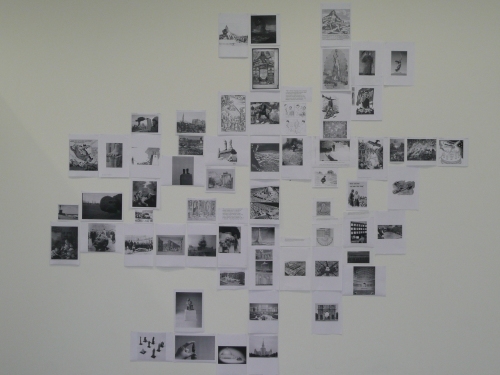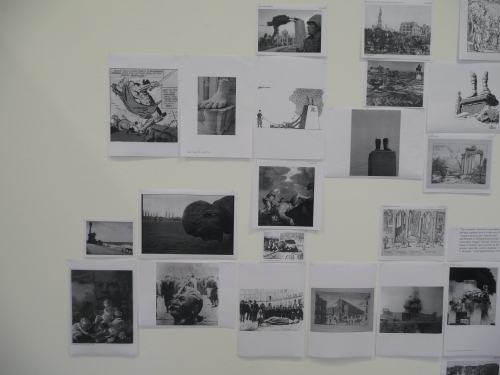
Visual Archive Exercise, Summer 2009
In late June and early July 2009 the students on the MA in Visual Culture at Manchester Metropolitan University engaged in what was termed a ‘Visual Archiving Exercise’, the aim of which was to develop a research process involving the collection and organisation of images around a particular theme, resulting in some form of display. The idea was that the display would be ‘archival’ in the way that art practices, such as Joachim Schmid’s ‘Archiv‘ and Gerhard Richter’s ‘Atlas‘, have been described as resulting from an archival impulse. Not an archive in the conventional sense of an institutional repository of documents organised in such a way that they can be easily retrieved and consulted, but rather a display that is the result of a search for images in a vastly more disparate archival field defined by both images on-line images and in print. As such, the Visual Archiving Exercise was meant to be methodologically and formally a bit like the panels produced by Aby Warburg for his ‘Mnemosyne‘ project. A project that Warburg described as ‘art history without a text’. The intention of the exercise was to explore the possibilities for research through the use of visual images. This would involve research on visual images at the same time. It would also necessitate the use of words – as search terms for the collection of visual images and in terms of the group discussion of what was being done with the images. It was also decided that some relevant quotations would be included in the display. Yet the primary focus would be upon the images themselves.
The student group decided upon the theme of ‘power’ and then identified search terms through which they would search for visual images, mostly on-line. These terms included, for example, ‘sovereignty’, ‘discipline’, ‘surveillance’, ‘symbolism’, ‘military technology’, and so on. The group searched for images individually and then brought them together in a studio space within the Fine Art department recently vacated by undergraduate students. The images were then organised on the floor of this space. Through various Visual Archive Exercise sessions more images were added and others were discarded. In this way the nature of the theme was fine-tuned. However, the resulting display remained pretty wide-ranging in the types of image it entailed and the sub-elements of the theme of power that it addressed. What resulted was a kind of tabular mapping of forms and aspects of power and of the kinds of imagery that are conventionally related to, or instrumental within power relations. Also present within this ‘map’ were images that related to the ruination and belittlement of power (for example, images related to Percy Shelley’s Ozymandias), and to acts of resistance and iconoclasm. Important for the latter was W. J. T. Mitchell’s idea of iconoclasm as ‘creative destruction’ through which the spectacular annihilation of a icon of power creates a new icon that itself functions as an idol (see W. J. T. Mitchell, What do pictures want? The lives and loves of images, The University of Chicago Press, 2005). Images were included that referred to the synoptic ‘God’s eye view’ of social administrators and political leaders – for example, the image of Albert Speer looking down at a model of the proposed Nazi reconstruction of Berlin as ‘Germania’. Such images were linked in group discussion to the position of the researcher as someone with the authority to select and organise images; an authority perhaps made manifest in the relationship between the horizontally arranged images and the vertical human researcher moving above, around and amongst them. This relationship was referenced in the display through the inclusion of a photograph of Andre Malraux working on his ‘Museum Without Walls’.

Visual Archive Exercise, Summer 2009
After the images were arranged on the floor, they were further edited through their arrangement on a wall using needle work pins. A smaller number of images were used for this final display. The research process and final display enabled the group to think about how knowledge and social relationships are in part embodied through images, how images are linked together within the cultural field, and how new links might be imaginatively forged through a research process of this type. Thus the exercise involved a form of creative iconography and a form of visual culture in itself.

Visual Archive Exercise, Summer 2009
Leave a comment